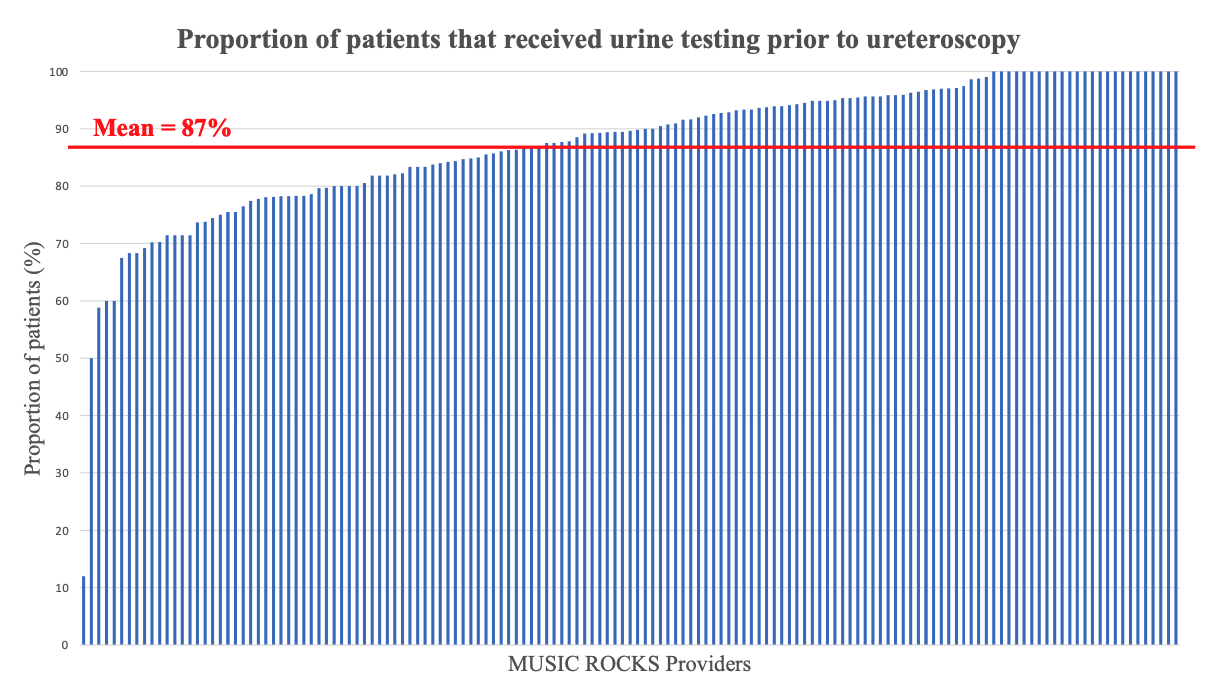Back
Poster, Podium & Video Sessions
Moderated Poster
MP13: Health Services Research: Practice Patterns, Quality of Life and Shared Decision Making I
MP13-20: Preoperative Urine Testing for Ureteroscopy in the State of Michigan: American Urological Association Guideline Adherence and Clinical Implications
Friday, May 13, 2022
2:45 PM – 4:00 PM
Location: Room 228
Hyung Joon Kim*, Stephanie Daignault-Newton, John M. DiBianco, Ann Arbor, MI, S. Mohammad Jafri, Royal Oak, MI, J. Rene Frontera, Saint Claire Shores, MI, Brian Seifman, Royal Oak, Troy, MI, Khurshid R. Ghani, Casey A. Dauw, for the Michigan Urological Surgery Improvement Collaborative, Ann Arbor, MI
- HK
Poster Presenter(s)
Introduction: The incidence of urinary tract infection (UTI) after ureteroscopy (URS) is relatively low, ranging between 1 and 3.7%, but the impact on patients can be profound. AUA guidelines strongly recommend urinalysis (UA) before URS, and urine culture (UC) is indicated in cases of suspected UTI. However, the real-world adherence to these guidelines regarding pre-operative urine testing is not well understood. We thus assessed preoperative urine testing rates prior to URS using data from a statewide registry and an online survey.
Methods: We used the Michigan Urologic Surgery Improvement Collaborative Reducing Operative Complications for Kidney Stones (MUSIC ROCKS) registry to understand the urine testing pattern by practices and providers in the state of Michigan. We identified patients undergoing URS from January 2020 to August 2021. In particular, we assessed rates of preoperative UA and UC within 60 days of surgery. Variation in UA/UC was assessed at a provider and practice level. Additionally, a collaborative-wide online survey based on AUA guideline statements was disseminated to assess how respondents’ feelings regarding testing measured up to actual practice.
Results: 6,964 procedures were performed across 23 practices and 145 urologists. UA and UC were performed in 5728 (82%), 3565 (51%) cases, respectively, with 6071 (87%) having UA and/or UC. UC without a UA was done in 341 (5%). There were substantial variations across providers and practices (12.0-100%, p<0.01 and 12.0-100%, p<0.01, respectively; Figure) in terms of preoperative urine testing (UA or UC). Among the 87 urologists who responded to the online survey (response rate: 31.4%, 87/277), 92% replied UA should be performed before URS. As for UC, 51% replied it should be performed “only if UA is positive”, while 28% felt it should always be performed.
Conclusions: Substantial variation exists amongst urologists and practices with regard to urine testing prior to URS in MUSIC ROCKS. An apparent gap in urologists’ sentiments regarding testing based on survey results and actual in-practice testing rates exists. Efforts are underway to improve the rates of preoperative urine testing in Michigan.
Source of Funding: Blue Cross Blue Shield of Michigan

Methods: We used the Michigan Urologic Surgery Improvement Collaborative Reducing Operative Complications for Kidney Stones (MUSIC ROCKS) registry to understand the urine testing pattern by practices and providers in the state of Michigan. We identified patients undergoing URS from January 2020 to August 2021. In particular, we assessed rates of preoperative UA and UC within 60 days of surgery. Variation in UA/UC was assessed at a provider and practice level. Additionally, a collaborative-wide online survey based on AUA guideline statements was disseminated to assess how respondents’ feelings regarding testing measured up to actual practice.
Results: 6,964 procedures were performed across 23 practices and 145 urologists. UA and UC were performed in 5728 (82%), 3565 (51%) cases, respectively, with 6071 (87%) having UA and/or UC. UC without a UA was done in 341 (5%). There were substantial variations across providers and practices (12.0-100%, p<0.01 and 12.0-100%, p<0.01, respectively; Figure) in terms of preoperative urine testing (UA or UC). Among the 87 urologists who responded to the online survey (response rate: 31.4%, 87/277), 92% replied UA should be performed before URS. As for UC, 51% replied it should be performed “only if UA is positive”, while 28% felt it should always be performed.
Conclusions: Substantial variation exists amongst urologists and practices with regard to urine testing prior to URS in MUSIC ROCKS. An apparent gap in urologists’ sentiments regarding testing based on survey results and actual in-practice testing rates exists. Efforts are underway to improve the rates of preoperative urine testing in Michigan.
Source of Funding: Blue Cross Blue Shield of Michigan


.jpg)
.jpg)